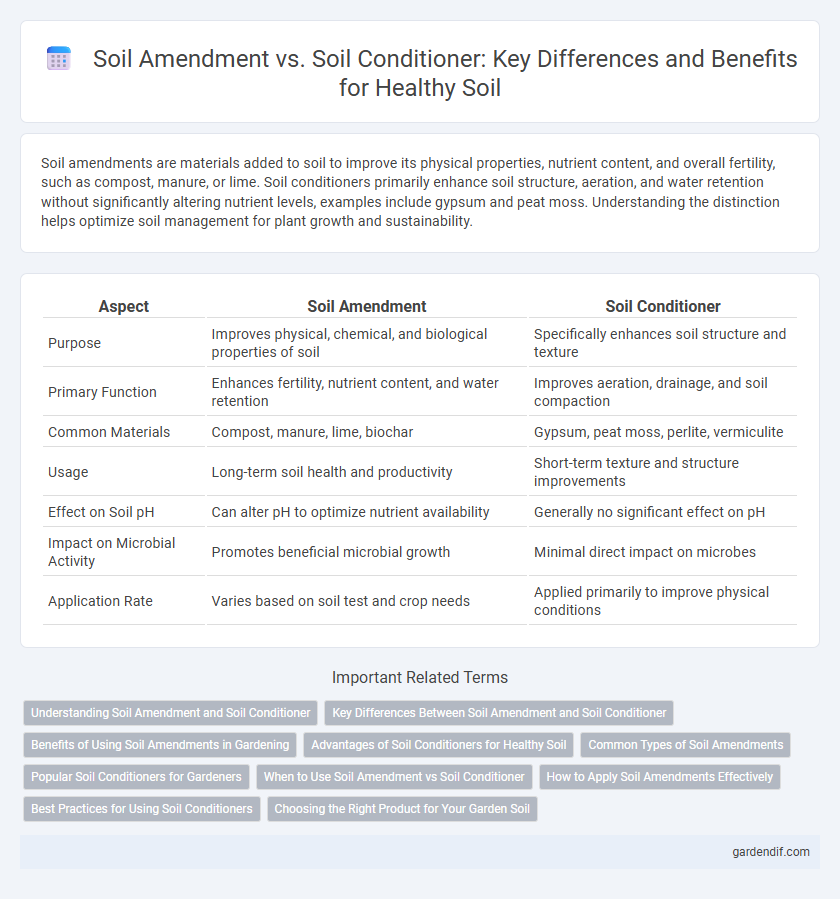
Soil Amendment vs Soil Conditioner Illustration
Soil amendments are materials added to soil to improve its physical properties, nutrient content, and overall fertility, such as compost, manure, or lime. Soil conditioners primarily enhance soil structure, aeration, and water retention without significantly altering nutrient levels, examples include gypsum and peat moss. Understanding the distinction helps optimize soil management for plant growth and sustainability.
Table of Comparison
| Aspect | Soil Amendment | Soil Conditioner |
|---|---|---|
| Purpose | Improves physical, chemical, and biological properties of soil | Specifically enhances soil structure and texture |
| Primary Function | Enhances fertility, nutrient content, and water retention | Improves aeration, drainage, and soil compaction |
| Common Materials | Compost, manure, lime, biochar | Gypsum, peat moss, perlite, vermiculite |
| Usage | Long-term soil health and productivity | Short-term texture and structure improvements |
| Effect on Soil pH | Can alter pH to optimize nutrient availability | Generally no significant effect on pH |
| Impact on Microbial Activity | Promotes beneficial microbial growth | Minimal direct impact on microbes |
| Application Rate | Varies based on soil test and crop needs | Applied primarily to improve physical conditions |
Understanding Soil Amendment and Soil Conditioner
Soil amendments are materials added to soil to improve its physical properties, such as texture, water retention, and nutrient availability, directly enhancing plant growth. Soil conditioners primarily improve soil structure and aeration, helping to alleviate compaction and increase microbial activity without significantly altering nutrient content. Understanding the distinct functions of soil amendments and conditioners is crucial for selecting the right product to optimize soil health and crop yield.
Key Differences Between Soil Amendment and Soil Conditioner
Soil amendments are materials added to soil to improve its physical properties, nutrient content, and overall fertility, often including compost, manure, or lime to adjust pH and nutrient levels. Soil conditioners primarily enhance soil structure and water retention without significantly altering nutrient content, examples include gypsum and peat moss. The key difference lies in amendments actively modifying nutrient profiles and pH, whereas conditioners focus on improving soil texture and moisture management.
Benefits of Using Soil Amendments in Gardening
Soil amendments improve garden soil by enhancing its texture, nutrient content, and water retention, promoting healthier plant growth and higher yields. Unlike soil conditioners that primarily adjust soil structure, amendments introduce essential organic matter or mineral elements that replenish soil fertility. Applying amendments such as compost, peat moss, or gypsum boosts microbial activity and ensures balanced pH levels, creating an optimal environment for root development and nutrient uptake.
Advantages of Soil Conditioners for Healthy Soil
Soil conditioners improve soil structure by enhancing its aeration, water retention, and nutrient availability, leading to healthier plant growth. Unlike soil amendments that primarily add nutrients, conditioners focus on optimizing soil physical properties, reducing compaction and erosion risks. The increased microbial activity and improved root development supported by soil conditioners contribute to sustainable soil fertility and overall ecosystem resilience.
Common Types of Soil Amendments
Common types of soil amendments include organic matter such as compost, manure, and peat moss, which improve soil structure and nutrient content. Inorganic amendments like gypsum, lime, and biochar adjust pH levels and enhance soil aeration and water retention. These materials differ from soil conditioners, which primarily focus on enhancing soil texture and reducing compaction without significantly altering nutrient levels.
Popular Soil Conditioners for Gardeners
Popular soil conditioners for gardeners include organic materials such as compost, peat moss, and coconut coir, which improve soil structure and water retention. Vermiculite and perlite are widely used inorganic conditioners that enhance aeration and drainage in garden soils. These conditioners help optimize root growth and nutrient availability, making them essential for healthy plant development.
When to Use Soil Amendment vs Soil Conditioner
Use soil amendments when the primary goal is to improve the soil's physical properties, such as enhancing nutrient content, water retention, or aeration, especially in degraded or nutrient-poor soils. Soil conditioners are best applied to adjust soil texture and structure for better root growth and moisture balance without significantly changing the nutrient levels, making them ideal for maintaining already fertile soils. Selecting between soil amendment and conditioner depends on soil test results indicating whether nutrient enrichment or structural improvement is the priority.
How to Apply Soil Amendments Effectively
Applying soil amendments effectively requires thorough soil testing to determine nutrient deficiencies and pH levels. Incorporate organic amendments like compost or manure evenly into the top 6-12 inches of soil to improve structure and fertility. Maintain proper moisture levels post-application to facilitate nutrient absorption and microbial activity essential for soil health.
Best Practices for Using Soil Conditioners
Soil conditioners improve soil structure and enhance water retention by incorporating organic matter such as compost or peat moss, promoting healthy root growth and microbial activity. Best practices for using soil conditioners include applying them evenly at the recommended rate before planting, incorporating them into the topsoil to a depth of 6-8 inches, and avoiding over-application to prevent nutrient imbalances. Regular soil testing helps determine the appropriate type and quantity of conditioners needed for optimal soil health and improved crop yields.
Choosing the Right Product for Your Garden Soil
Soil amendments like compost, manure, and peat moss primarily improve soil fertility and nutrient content, enhancing plant growth by replenishing essential minerals. Soil conditioners such as gypsum or vermiculite focus on improving soil structure, water retention, aeration, and drainage, which benefits root development and reduces soil compaction. Selecting the right product depends on your garden's specific needs--use amendments for nutrient deficiencies and conditioners to improve physical soil properties.
Soil Amendment vs Soil Conditioner Infographic

 gardendif.com
gardendif.com